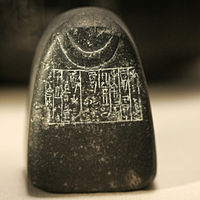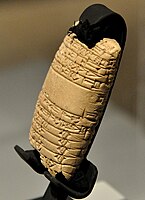Shulgi
| Shulgi 𒀭𒂄𒄀 | |
|---|---|
  | |
| King of theNeo-Sumerian Empire | |
| Reign | c. 2094 BC– 2046 BC |
| Predecessor | Ur-Nammu |
| Successor | Amar-Sin |
| Issue | Amar-Sin,Liwir-Mitashu |
| Dynasty | 3rd Dynasty of Ur |
| Father | Ur-Nammu |
| Mother | Watartum |
(c. 2094–2046 BC)
nin-a-ni..................... "his Lady,"
šul-gi.................... "Shulgi"
nitah kalag-ga...... "the mighty man"
lugal........................ "King"
urimki-ma............... "of Ur"
lugal ki-en-............... "King ofSumer"
gi ki-uri-ke4................. "andAkkad,"
e2-a-ni.......................... "her Temple"
mu-na-du3................... "he built"[4]
Shulgi(𒀭𒂄𒄀dšul-gi,formerly read asDungi) ofUrwas the second king of theThird Dynasty of Ur.He reigned for 48 years, fromc. 2094– c. 2046 BC(Middle Chronology) or possiblyc. 2030– 1982 BC (Short Chronology).[5][6][7]His accomplishments include the completion of construction of theGreat Ziggurat of Ur,begun by his fatherUr-Nammu.On his inscriptions, he took the titles "King of Ur", "King of Sumer and Akkad"and"King of the four corners of the universe".He used the symbol for divinity (𒀭) before his name, marking hisapotheosis,from the 23rd year of his reign.[8]
Life and reign[edit]
Shulgi was the son ofUr-Nammuking ofUrand his queen consort Watartum. Year-names are known for all 48 years of his reign, providing a fairly complete contemporary view of the highlights of his career.[9]
Shulgi is best known for his extensive revision of the scribal school's curriculum. Although it is unclear how much he actually wrote, there are numerous praise poems written by and directed towards this ruler. He proclaimed himself a god in his 23rd regnal year,[10]and was recognized as such by the whole ofSumerandAkkad.[11]
Some early chronicles castigate Shulgi for his impiety: TheWeidner Chronicle(ABC 19)[12]states that "he did not perform his rites to the letter, he defiled his purification rituals". CM 48[13]charges him with improper tampering with the rites, composing "untruthful stelae, insolent writings" on them. TheChronicle of Early Kings(ABC 20)[14]accuses him of "criminal tendencies, and the property ofEsagilaandBabylonhe took away as booty. "
Name[edit]
Early uncertainties about the reading of cuneiform led to the readings "Shulgi" and "Dungi" being common transliterations before the end of the 19th century. However, over the course of the 20th century, the scholarly consensus gravitated away fromduntowardsshulas the correct pronunciation of the𒂄sign. The spelling of Shulgi's name by scribes with thediĝirdeterminative reflects hisdeificationduring his reign, a status and spelling previously claimed by hisAkkadianpredecessorNaram-Sin.[8]
-
Portraits of Shulgi from hisNuskaseal.Louvre Museum
-
Portrait of Shulgi as a builder, on a foundation nail.Metropolitan Museum of Art
Personal glorification[edit]

Shulgi also boasted about his ability to maintain high speeds while running long distances. He claimed in his 7th regnal year to have run fromNippurtoUr,a distance of not less than 100 miles.[15]Kramer refers to Shulgi as "The first long distance running champion."[16]
Shulgi wrote a long royal hymn to glorify himself and his actions, in which he refers to himself as "the king of the four-quarters, the pastor of theblack-headed people".[17]
Shulgi claimed that he spokeElamiteas well as he spokeSumerian.[8]
Some scholars note how he self identified as a "mathematical god" and considers the state he ruled over as the "first mathematical state", citing his praise poems that emphasize his abilities in subtraction, addition calculation and accounting.[18]
Armed conflicts[edit]
WhileDerhad been one of the cities whose temple affairs Shulgi had directed in the first part of his reign, in his 20th year he claimed that the gods had decided that it now be destroyed, apparently as some punishment. The inscriptions state that he "put its field accounts in order" with the pick-axe. His 18th year-name wasYear Liwir-mitashu, the king's daughter, was elevated to the ladyship inMarhashi,referring to a country east of Elam and her dynastic marriage to its king, Libanukshabash. Following this, Shulgi engaged in a period of expansionism at the expense of highlanders such as theLullubi,and destroyedSimurrum(anothermountain tribe) andLulubumnine times between the 26th and 45th years of his reign.[19]In his 30th year, his daughter was married to the governor ofAnshan;in his 34th year, he was already levying a punitive campaign against the place. He also destroyed Kimaš and Ḫurti (cities to the east ofUr,somewhere inElam) in the 45th year of his reign.[20][19]Ultimately, Shulgi was never able to rule any of these distant peoples; at one point, in his 37th year, he was obliged to build a large wall in an attempt to keep them out.[15]
Susa[edit]
(c. 2094–2047 BCE)
nin-a-ni....................... "his Lady,"
dšul-gi.................... "Shulgi"
nitah kalag-ga........ "the mighty man"
lugal urimki-ma..... "King of Ur"
lugal ki-en-................. "King ofSumer"
gi ki-uri-ke4..................... "andAkkad,"
nam-ti-la-ni-še3........... "for his life"
a mu-na-ru................... "dedicated (this)"
Shulgi is known to have made dedications atSusa,as foundation nails with his name, dedicated to godInshushinakhave been found there.[26]One of the votive foundation nails reads:"The god 'Lord of Susa,' his king, Shulgi, the mighty male, king of Ur, king of Sumer and Akkad, the..., his beloved temple, built.".[27][28][29]Anetched carnelian bead,now located in the Louvre Museum (Sb 6627) and inscribed with a dedication by Shulgi was also found in Susa, the inscription reading:"Ningal,his mother, Shulgi, god of his land, King of Ur, King of the four world quarters, for his life dedicated (this) ".[30][31][32]
The Ur III dynasty had held control over Susa since the demise ofPuzur-Inshushinak,and they built numerous buildings and temples there. This control was continued by Shulgi as shown by his numerous dedications in the city-state.[33]He also engaged in marital alliances, by marrying his daughters to rulers of eastern territories, such asAnšan,MarhashiandBashime.[33]
-
Votive tablet of Shulgi, excavated in Susa: "For the goddessNinhursagofSusa,his Lady, Shulgi, the great man, King of Ur, King of Sumer and Akkad, built her temple ".Louvre Museum,Sb 2884.[34][35]
-
Carnelian bead with dedicatory inscription by Shulgi, found inSusa.Louvre Museum, Sb 6627
Modernization[edit]
Shulgi apparently led a major modernization of theThird Dynasty of Ur.[8]He improved communications, reorganized the army, reformed the writing system and weight and measures, unified the tax system, and created a strongbureaucracy.[8]He also promulgated the law code known as theCode of Ur-Nammuafter his father.[8]
Year names[edit]

There are extensive remains for the year names of Shulgi, which have been entirely reconstructed from year 1 to year 48. Some of the most important are:[37]
1. Year: Šulgi is king
2. Year: The foundations of the temple of Ningubalag were laid
6. Year: The king straightened out the Nippur road
7. Year: The king made a round trip between Ur and Nippur (in one day)
10. Year: The royalmountain-house(the palace) was built
18. Year: Liwirmittašu, the daughter of the king, was elevated to the queenship ofMarhashi
21c. Year:Derwas destroyed
24. Year:Karaharwas destroyed
25. Year:Simurrumwas destroyed
27. Year after: "Šulgi the strong man, the king of the four corners of the universe, destroyed Simurrum for the second time"
27b. Year: "Harszi was destroyed"
30. Year: The governor ofAnšantook the king's daughter into marriage
31. Year: Karhar was destroyed for the second time
32. Year: Simurrum was destroyed for the third time
34. Year: Anshan was destroyed
37. Year: The wall of the land was built
42. Year: The king destroyed Šašrum
44. Year: Simurrum andLullubumwere destroyed for the ninth time
45. Year: Šulgi, the strong man, the king of Ur, the king of the four-quarters, smashed the heads of Urbilum, Simurrum, Lullubum and Karhar in a single campaign
46. Year: Šulgi, the strong man, the king of Ur, the king of the four-quarters, destroyed Kimaš, Hurti and their territories in a single day
Marriages[edit]
Shulgi was a contemporary of theShakkanakkurulers ofMari,particularlyApil-kinandIddi-ilum.[40][41]An inscription mentions thatTaram-Uram,the daughter of Apil-kin, became the "daughter-in-law" ofUr-Nammu,and therefore the Queen of king Shulgi.[42][43]In the inscription, she called herself "daughter-in-law ofUr-Nammu",and" daughter of Apil-kin,Lugal( "King" ) of Mari ", suggesting for Apil-kin a position as a supreme ruler, and pointing to a marital alliance between Mari andUr.[44][45]
Nin-kallawas a queen at the end of the king's reign. Many texts show that she was running the palace in Nippur.[46] Another important royal woman, but not a queen, wasEa-niša.She appears in many texts and had an influential position at the royal court, perhaps as concubine.[47]A similar status hadShulgi-simtiwho is known from a high number of texts presenting evidence for her economic power. Another important woman wasGeme-Ninlillawho appears in texts at the end of the king's reign. Other, less well known royal women areŠuqurtumandSimat-Ea.
Shulgi is known to have had five sons, Amar-dDa-mu, Lu-dNanna, Lugal-a-zi-da, Ur-dSuen,Amar-Sinas well as one daughter, Peš-tur-tur.[48][49]The name of another daughter, Šāt-Kukuti, is known from a cuneiform tablet.[50]A daughter, Taram-Šulgi was married to the ruler of Pašime, Šudda-bani.[42]
Artifacts and inscriptions[edit]
-
Lugal Urimkima/ Lugal Kiengi Kiuri𒈗𒋀𒀊𒆠𒈠𒈗𒆠𒂗𒄀𒆠𒌵,"King ofUr,King of Sumer and Akkad,on a votive tablet of Shulgi. The finalke4𒆤is the composite of -k (genitive case) and -e (ergative case).[51]
-
Shulgi completed the greatZiggurat of Ur
-
Earrings inscribed in the name of Shulgi.[52]
-
Seal of Shulgi, with worshipper and seated deity: "Shulgi, the mighty hero, King of Ur, king of the four regions, Ur-(Pasag?) the scribe, thy servant".[53]
-
Mace head in the name of Shulgi (inscription upside down). British Museum.
-
Duck-shaped official weight of 2 mina, reign of Shulgi, from Ur, Iraq. British Museum.
-
Weight of+1⁄2mina (actual weight 248 gr.) dedicated by King Shulgi and bearing the emblem of the crescent moon: it was used in the temple of the Moon-God at Ur. Diorite, beginning of the 21st century BC (Ur III). Louvre Museum, Department of Oriental Antiquities, Richelieu, first floor, room 2, case 6
-
Tablet of Shulgi, glorifies the king and his victories on the Lullubi people and mentions the modern-city of Erbil and the modern-district of Sulaymaniyah, Sulaymaniyah Museum, Iraq
See also[edit]
References[edit]
- ^Full transcription:"CDLI-Archival View".cdli.ucla.edu.
- ^"Nimintabba tablet".British Museum.
- ^Enderwitz, Susanne; Sauer, Rebecca (2015).Communication and Materiality: Written and Unwritten Communication in Pre-Modern Societies.Walter de Gruyter GmbH & Co KG. p. 28.ISBN978-3-11-041300-7.
- ^ab"(For the goddess) Nimintabba, his lady, Shulgi, mighty man, king of Ur, king of Sumer and Akkad, her house, built." inExpedition.University Museum of the University of Pennsylvania. 1986. p. 30.
- ^The Oxford companion to archaeology. 1. Ache-Hoho.Oxford University Press. 2012. p. 458.ISBN9780195076189.
- ^"Shulgi | king of Ur".Encyclopedia Britannica.
- ^"Ur III Empire – Oxford Reference".Oxfordreference.
- ^abcdefPotts, D. T. (1999).The Archaeology of Elam.Cambridge University Press. p. 132.ISBN9780521564960.
- ^"T6K2.htm".Cdli.ucla.edu.Retrieved7 August2019.
- ^Van De Mieroop, Marc. (2005).A History of the Ancient Near East ca. 3000–323 BC,Oxford: Blackwell Publishing, p. 76
- ^Woolley, C. Leonard.The Sumerians.New York:W. W. Norton.pp.132.ISBN0-393-00292-6.
- ^"The Weidner Chronicle (ABC 19)".Archived fromthe originalon 28 February 2006.
- ^"The kings of Ur (CM 48)".Archived fromthe originalon 10 May 2006.
- ^"Chronicle of early kings (ABC 20)".Archived fromthe originalon 28 February 2006.
- ^abHamblin, William J.Warfare in the Ancient Near East to 1600 BC.New York: Routledge, 2006.
- ^See hisHistory Begins at Sumer,Chapter 31, "Shulgi of Ur: The First Long-Distance Champion".
- ^"I am the king of the four-quarters, I am a shepherd, the pastor of the" black-headed people "" inLiverani, Mario (2013).The Ancient Near East: History, Society and Economy.Routledge. p. 167.ISBN978-1-134-75084-9.
- ^"Red Traces, Part 11: The social origins of early mathematics".counterfire.
- ^abSamuel Noah Kramer (17 September 2010).The Sumerians: Their History, Culture, and Character.University of Chicago Press.ISBN978-0-226-45238-8.
- ^Ghobadizadeh, Hamzeh and Sallaberger, Walther, "Šulgi in the Kuhdasht Plain: Bricks from a Battle Monument at the Crossroads of Western Pish-e Kuh and the Localisation of Kimaš and Ḫurti", Zeitschrift für Assyriologie und vorderasiatische Archäologie, vol. 113, no. 1, pp. 3-33, 2023
- ^(RIME 3/2, p. 161-162)
- ^"DINGIR.NIN.LILA / NIN-A-NI / DINGIR.SHUL.GI / NITA-KALAG.GA / LUGAL URI/.KI-MA / LUGAL.KI.EN / GI KI-URI3.KI / NAM.TI.LA NI.SHE3/ A MU.NA.RU." Inscription Translation: "To Ninlil, his lady, Shulgi, mighty man, King of Ur, King of Sumer and Akkad, has dedicated (this stone) for the sake of his life.""cylinder seal / bead".British Museum.
- ^"CDLI-Archival View".cdli.ucla.edu.
- ^Sb 6627Potts, Daniel T. (1999).The Archaeology of Elam: Formation and Transformation of an Ancient Iranian State.Cambridge University Press. p. xiv.ISBN978-0-521-56496-0.
- ^Art of the First Cities: The Third Millennium B.C. from the Mediterranean to the Indus.Metropolitan Museum of Art. 2003. p. 243.ISBN978-1-58839-043-1.
- ^Potts, Professor Daniel T. (1999).The Archaeology of Elam: Formation and Transformation of an Ancient Iranian State.Cambridge University Press. p. xiv.ISBN978-0-521-56496-0.
- ^"CDLI-Found Texts Louvre Museum Sb 2881".cdli.ucla.edu.
- ^"Votive Foundation Nails".dla.library.upenn.edu.
- ^Potts, Daniel T. (1999).The Archaeology of Elam: Formation and Transformation of an Ancient Iranian State.Cambridge University Press. p. 133, Plate 5.1.ISBN978-0-521-56496-0.
- ^Potts, D.T (29 July 1999).The Archaeology of Elam.p. 134, Plate 5.2 Sb 6627.ISBN9780521564960.
- ^"Site officiel du musée du Louvre".cartelfr.louvre.fr.
- ^"Shulgi perle (color image)".Louvre Museum.
- ^abPotts, Daniel T. (2012).A Companion to the Archaeology of the Ancient Near East.John Wiley & Sons. p. 746.ISBN978-1-4051-8988-0.
- ^"Site officiel du musée du Louvre".cartelfr.louvre.fr.
- ^"BnF – L'Aventure des écritures".classes.bnf.fr.
- ^ab"Šulgi Year Names (Ist Ni 00394)".cdli.ox.ac.uk.
- ^Hamblin, William J. (2006).Warfare in the Ancient Near East to 1600 BC: Holy Warriors at the Dawn of History.Routledge. p. 121.ISBN978-1-134-52062-6.
- ^"Šulgi Year Names".cdli.ox.ac.uk.
- ^https://cdli-gh.github.io/year-names/HTML/T6K2.htmComplete list of Šulgi Year Names]
- ^Unger, Merrill F. (2014).Israel and the Aramaeans of Damascus: A Study in Archaeological Illumination of Bible History.Wipf and Stock Publishers. p. 5.ISBN978-1-62564-606-4.
- ^Abusch, I. Tzvi; Noyes, Carol (2001).Proceedings of the XLV Rencontre Assyriologique Internationale: historiography in the cuneiform world.CDL Press. p. 60.ISBN978-1-883053-67-3.
- ^abSharlach, T. M. (2017).An Ox of One's Own: Royal Wives and Religion at the Court of the Third Dynasty of Ur.Walter de Gruyter GmbH & Co KG. p. 207.ISBN978-1-5015-0522-5.
- ^Eppihimer, Melissa (2019).Exemplars of Kingship: Art, Tradition, and the Legacy of the Akkadians.Oxford University Press. p. 121.ISBN978-0-19-090303-9.
- ^Lipiński, Edward (1995).Immigration and Emigration Within the Ancient Near East.Peeters Publishers. p. 187.ISBN9789068317275.
- ^CIVIL, Michel (1962). "Un nouveau synchronisme Mari-III e dynastie d'Ur".Revue d'Assyriologie et d'archéologie orientale.56(4): 213.ISSN0373-6032.JSTOR23295098.
- ^T. M. Sharlach:An Ox of One's Own, Royal Wives and Religion at the Court of the Third Dynasty of Ur,Walter de Gruyter GmbH, Berlin/Boston 2017, ISBN 978-1-5015-1447-0, 102-115
- ^T. M. Sharlach:An Ox of One's Own, Royal Wives and Religion at the Court of the Third Dynasty of Ur,Walter de Gruyter GmbH, Berlin/Boston 2017, ISBN 978-1-5015-1447-0, 140-157
- ^Changyu Liu, "Prosopography of individuals delivering animals to Puzriš-Dagan in Ur III Mesopotamia", Akkadica 142/2, 2021, pp. 113-142
- ^[1]Changyu Liu, "Prosopographical Statistics Appendix of the article 'Prosopography of individuals delivering animals to Puzriš-Dagan in Ur III Mesopotamia'", Cuneiform Digital Library Preprints, 24.0, 1 April 2022
- ^Ali, Basil Bashar, and Khalid Salim Ismael, "Šāt-kukuti The Daughter of King Šulgi in a New Text from the Iraqi Museum", Athar Alrafedain 8.2, pp. 266-280, 2023
- ^Edzard, Dietz Otto (2003).Sumerian Grammar.BRILL. p. 36.ISBN978-90-474-0340-1.
- ^"CDLI-Archival View".cdli.ucla.edu.
- ^abWard, William Hayes (1910).The seal cylinders of western Asia.Washington: Carnegie Inst. p.27.
- ^abSimo Parpola, Asko Parpola and Robert H. Brunswig, Jr"The Meluḫḫa Village: Evidence of Acculturation of Harappan Traders in Late Third Millennium Mesopotamia?"in Journal of the Economic and Social History of the Orient Vol. 20, No. 2, 1977, p. 136-137
- ^"Collections Online British Museum".britishmuseum.org.
External links[edit]
- Shulgi's axe sold illegally in Germanyfrom the German Middle East magazine zenith
- The face of Shulgi. A realistic statue shows us how Shulgi may have looked in real life.



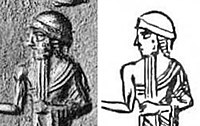
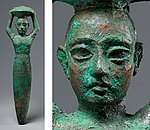


![Votive tablet of Shulgi, excavated in Susa: "For the goddess Ninhursag of Susa, his Lady, Shulgi, the great man, King of Ur, King of Sumer and Akkad, built her temple ". Louvre Museum, Sb 2884.[34][35]](https://upload.wikimedia.org/wikipedia/commons/thumb/5/55/Votive_tablet_of_Shulgi%2C_excavated_in_Susa%2C_SB_2880.jpg/150px-Votive_tablet_of_Shulgi%2C_excavated_in_Susa%2C_SB_2880.jpg)
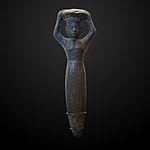
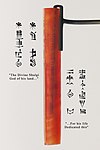
![Lugal Urimkima/ Lugal Kiengi Kiuri 𒈗𒋀𒀊𒆠𒈠𒈗𒆠𒂗𒄀𒆠𒌵, "King of Ur, King of Sumer and Akkad, on a votive tablet of Shulgi. The final ke4 𒆤 is the composite of -k (genitive case) and -e (ergative case).[51]](https://upload.wikimedia.org/wikipedia/commons/thumb/b/b9/Lugal_Urimkima_Lugal_Kiengi_Kiuri%2C_King_of_Ur%2C_King_of_Sumer_and_Akkad%2C_on_a_seal_of_Shulgi_%28transcription%29.jpg/200px-Lugal_Urimkima_Lugal_Kiengi_Kiuri%2C_King_of_Ur%2C_King_of_Sumer_and_Akkad%2C_on_a_seal_of_Shulgi_%28transcription%29.jpg)
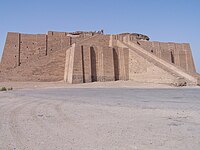
![Earrings inscribed in the name of Shulgi.[52]](https://upload.wikimedia.org/wikipedia/commons/thumb/c/ce/Earrings_from_Shulgi.JPG/200px-Earrings_from_Shulgi.JPG)
![Seal of Shulgi, with Gilgamesh fighting a winged monster: "To Shulgi, son of the king, Ur-dumuzi the scribe, his servant".[53]](https://upload.wikimedia.org/wikipedia/commons/thumb/d/dc/Seal_of_Shulgi%2C_with_Gilgamesh_fighting_a_winged_monster.jpg/200px-Seal_of_Shulgi%2C_with_Gilgamesh_fighting_a_winged_monster.jpg)
![Seal of Shulgi, with worshipper and seated deity: "Shulgi, the mighty hero, King of Ur, king of the four regions, Ur-(Pasag?) the scribe, thy servant".[53]](https://upload.wikimedia.org/wikipedia/commons/thumb/f/fb/Seal_of_Shulgi%2C_with_worshipper_and_seated_deity.jpg/200px-Seal_of_Shulgi%2C_with_worshipper_and_seated_deity.jpg)


![A tablet from the period of Shulgi, mentioning the "Meluhha" village in Sumer. British Museum, BM 17751.[54] "Meluhha" (𒈨𒈛𒄩𒆠) actually appears on the beginning of the other side (column II, 1) in the sentence "The granary of the village of Meluhha".[55][54]](https://upload.wikimedia.org/wikipedia/commons/thumb/7/79/Meluhha_village_tablet_-_BM17751.jpg/142px-Meluhha_village_tablet_-_BM17751.jpg)
